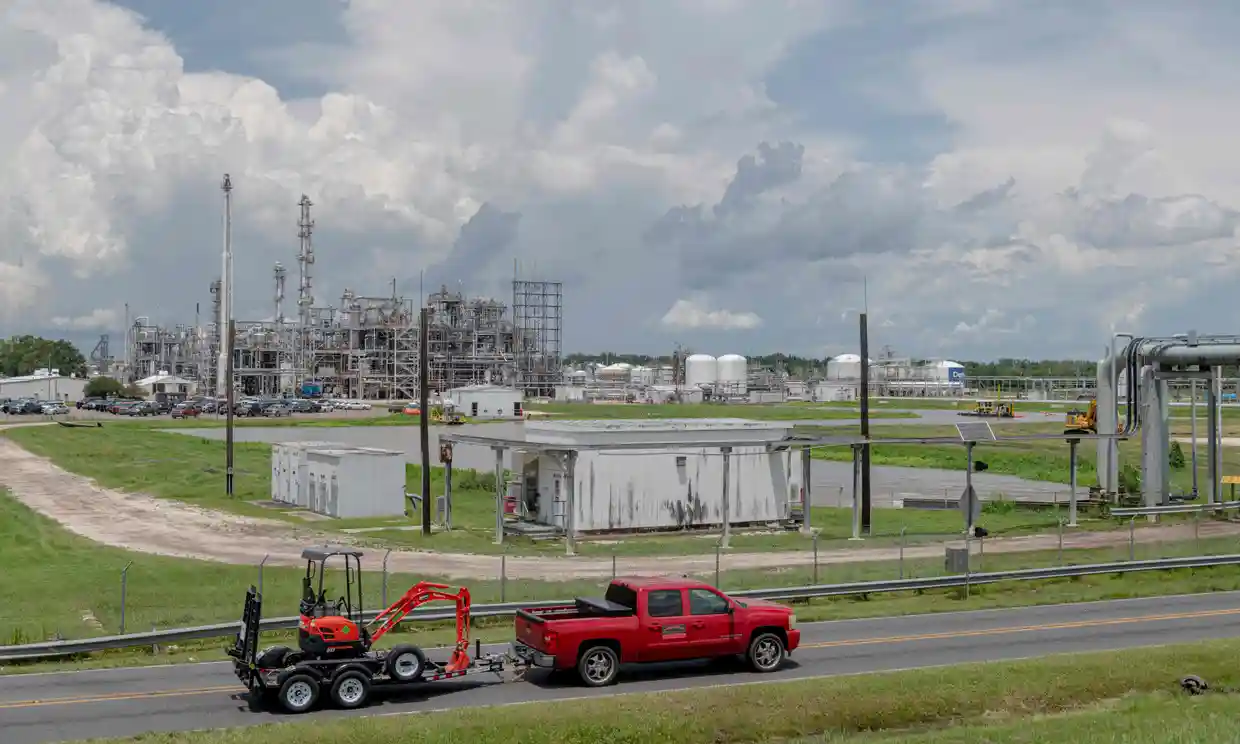Carbon-capture gold rush an ‘insult’ to locals in emissions-hit Louisiana
Millions of dollars of investments in new carbon capture projects in Louisiana – with more announced this week, are unwelcome developments to some environmental activists in the state.

Published in the Guardian, Verite and Louisiana Illuminator
Millions of dollars of investments in new carbon capture projects in Louisiana – with more announced this week, are unwelcome developments to some environmental activists in the state.
“We’ve been trying to fix the oil and gas damage, while at the same time trying to push the transition away from it,” said Monique Harden, director of law for the Deep South Center for Environmental Justice.
“And now we have carbon-capture and sequestration to contend with,” added Harden, whose group is a member of Louisiana Against False Solutions, a coalition of environmental and watchdog non-profits fighting the carbon capture projects.
Carbon capture technology, supported by the U.S. government, the fossil fuel industry and some environmental groups, does not yet exist on a meaningful scale. Some climate experts worry the focus on the technology will distract from and undermine efforts to phase out fossil fuels.
About 30 carbon-capture projects have been proposed in Louisiana – all of them spurred by federal subsidies and most supercharged by increased incentives in the Inflation Reduction Act intended to address global heating.
A total of 170 projects have been announced nationwide, with only Texas having as many projects as Louisiana. On Friday, the Department of Energy announced $1.2bn investment in carbon capture projects in Louisiana and Texas.
Environmental justice advocates and other opponents of carbon capture and sequestration say the technology is environmentally and economically risky and encourages the status quo for fossil fuel companies. One oil company CEO said earlier this year that carbon capture will help “preserve our industry over time”.
The IRA increased tax credits, called 45Q, to permanently store carbon from $50 per ton to $85 per ton. Directly capturing the carbon from ambient air earns developers $180 per ton. The law also allows the credit to be paid in cash to developers, which include companies or subsidiaries of Shell, ExxonMobil and Koch.
The technology’s backers include Jennifer Granholm, the energy secretary, who talked up its potential in a press conference call about the new investment. “If we deploy this at scale, this technology can help us make serious headway toward our net zero emissions goals while we are still focused on deploying more clean energy at the same time,” she said.
“It’s hard to imagine a future where we actually solve climate change without carbon capture,” says John Thompson, markets and technology director at the Clean Air Task Force, which supports carbon capture and tracks project announcements.
Modeling conducted by the International Energy Agency indicates carbon capture will be necessary to reach net zero by 2050 and backers of the technology say it’s a must for industries including steel, cement and chemicals, where there’s no good substitute for fossil fuels.
However, in Louisiana, one issue for opponents is that carbon capture is being proposed as a component of mostly brand new facilities for ammonia, hydrogen and biomass, among others, with the products produced at those sites labeled by developers as “green” or “clean”.
“What we aren’t seeing is announcements to retrofit refineries or existing ammonia facilities, or other petrochemical facilities. That automatically means we are only seeing net new emissions,” said Logan Atkinson Burke, executive director of the Alliance for Affordable Energy, an energy consumer advocacy group.
At least two projects in the state will retrofit existing facilities. Cleco’s project to retrofit a portion of a power plant near Alexandria, and CF Industries has announced it will retrofit its ammonia facility in Ascension parish to capture carbon dioxide.
Louisiana, with about 1% of the nation’s population, already emits more than 4% of the United State’s greenhouse gases because of its heavy industrial base. A Louisiana greenhouse gas inventory shows new announced projects, if built, are projected to increase global warming emissions from 142m metric tons (MMT) of carbon dioxide or equivalent, to 243 MMT by 2026.
More than half of those new emissions will come from the state’s new liquefied natural gas plants, and a third from new chemical plants. Only some of those projects are planned to have carbon capture, but even if the equipment captures the industry’s promised 95% of carbon emissions, the rest will be released into the atmosphere.
Jessie Stolark, executive director of the Carbon Capture Coalition, a non-partisan collaboration of more than 100 companies, unions, conservation and environmental policy organizations, says the “vast majority” of carbon capture projects in the nation will be placed on existing facilities. She adds, however, that carbon capture is only economical on the newest and most efficient facilities.
Louisiana is a locus for carbon capture projects exactly because of its heavy concentration of industry, meaning there’s more opportunity to capture carbon, said David Dismukes, an economic consultant and the former director of Louisiana State University’s Center for Energy Studies, who produced the state’s greenhouse gas inventory.
Support for the technology from the state’s Democratic governor, John Bel Edwards, has helped pave the way for CCS development. “I know it is an essential part not just to our climate action plan here in Louisiana to reduce greenhouse gas emissions to net zero by 2050, but really the plans for our country and the world,” Edwards said in December.
Projects in the state can’t proceed until the Environmental Protection Agency gives Louisiana the authority to regulate injections of carbon underground. The EPA has proposed giving that authority to Louisiana’s environmental regulators – a decision that was met with protest from environmental groups during a three-day hearing in June. A final decision has not yet been issued.
Several of the projects are being built near polluting industries that line the Mississippi River corridor, from Baton Rouge to New Orleans, known as “Cancer Alley”.
“These are new projects that are putting more pollution in the existing communities that are already overburdened. It’s a new insult to these communities,” said Jade Woods, an organizer with the Center for International Environmental Law.
Residents around Lake Maurepas unsuccessfully fought the development of carbon capture storage under their lake in court and in the legislature.
Air Products, which is developing the Maurepas site, hired 25 lobbyists for the last Louisiana legislative session, where multiple bills about carbon capture development were introduced. Only one of those measures, to share state revenue from the projects with local communities, passed.
“One hundred per cent of everyone I talk with is opposed to this,” said Tangipahoa councilwoman Kim Coates, about the Lake Maurepas project. Multiple parish councils and local agencies oppose the plan – which so far has involved setting 17,000 explosive charges in the lake to determine its underground geology. But in the end, Coates said, the people who lived around the lake had no say.
“It was all about putting the money first.”
Floodlight depends on a community of readers like you who are committed to supporting nonprofit investigative journalism. Donate to see more stories like this one.


